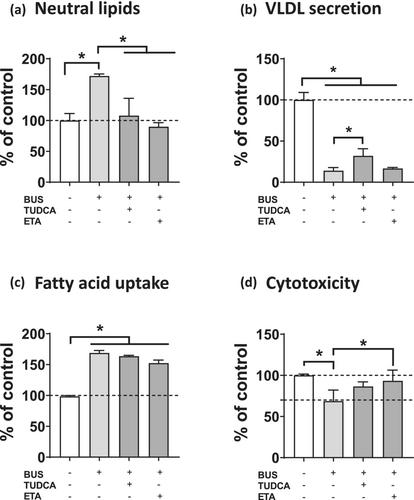Busulfan induces steatosis in HepaRG cells but not in primary human hepatocytes: Possible explanations and implication for the prediction of drug-induced liver injury
Abstract
Background
The antineoplastic drug busulfan can induce different hepatic lesions including cholestasis and sinusoidal obstruction syndrome. However, hepatic steatosis has never been reported in patients.
Objectives
This study aimed to determine whether busulfan could induce steatosis in primary human hepatocytes (PHH) and differentiated HepaRG cells.
Methods
Neutral lipids were determined in PHH and HepaRG cells. Mechanistic investigations were performed in HepaRG cells by measuring metabolic fluxes linked to lipid homeostasis, reduced glutathione (GSH) levels, and expression of genes involved in lipid metabolism and endoplasmic reticulum (ER) stress. Analysis of two previous transcriptomic datasets was carried out.
Results
Busulfan induced lipid accumulation in HepaRG cells but not in six different batches of PHH. In HepaRG cells, busulfan impaired VLDL secretion, increased fatty acid uptake, and induced ER stress. Transcriptomic data analysis and decreased GSH levels suggested that busulfan-induced steatosis might be linked to the high expression of glutathione S-transferase (GST) isoenzyme A1, which is responsible for the formation of the hepatotoxic sulfonium cation conjugate. In keeping with this, the GST inhibitor ethacrynic acid and the chemical chaperone tauroursodeoxycholic acid alleviated busulfan-induced lipid accumulation in HepaRG cells supporting the role of the sulfonium cation conjugate and ER stress in steatosis.
Conclusion
While the HepaRG cell line is an invaluable tool for pharmacotoxicological studies, it might not be always an appropriate model to predict and mechanistically investigate drug-induced liver injury. Hence, we recommend carrying out toxicological investigations in both HepaRG cells and PHH to avoid drawing wrong conclusions on the potential hepatotoxicity of drugs and other xenobiotics.


 求助内容:
求助内容: 应助结果提醒方式:
应助结果提醒方式:


